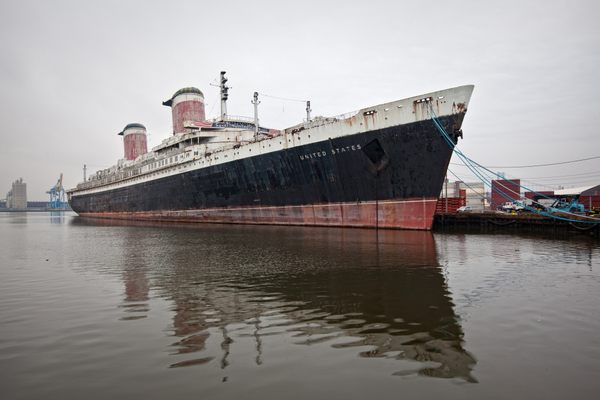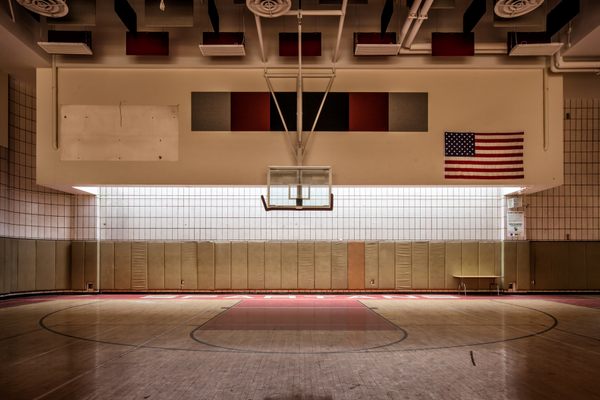An Education in Decay: Inside a Decrepit Elementary School in Harlem
It is not a critique of the American education system to say that West Harlem’s P.S. 186 is in a state of wretched disrepair: the building is literally crumbling on its foundation.
Once a New York City public school, the building now serves the neighborhood only through the berries which fall from trees growing in its trash-heaped, rat-infested, locked off courtyard. Neighborhood kids collect and sell them in woven baskets. “The darkest ones are sweetest,” one boy told me, jumping to rip off a ripe branch. When I asked if he ever ventured into the school looming behind him, he said he had no idea what the building was.
Built by acclaimed superintendent and chief architect for New York City schools Charles B. J. Snyder, P.S. 186 is just one of over 400 public schools he built during his 30-year tenure. 300 of them are still in use, one of them being my high school on the Lower East Side. The H-design of the building is one of Snyder’s trademarks, inspired by an 1896 trip to Paris when he saw the Hotel de Cluny, and repurposed the layout to provide students with more recreational space and grand courtyard entrances.
The experience of exploring this sepulchral relic in West Harlem, decayed nearly beyond recognition, was thus incredibly surreal for me. Through the broken glass and the graffiti, the pigeon carcasses and the rust, I recognized the same helix-style staircases I walk to class on; behind the broken down closet doors, next to a five-foot hole leading into the next room, are the same phallic coat hooks I laugh at in math class (although some of these have melted into other shapes).
There are identical large windows, only these let in all of the elements, not just the sun; and my auditorium has the same blueprint, only our ceiling is intact and there aren’t empty 40s strewn about the floor, or weeds growing out of the walls. The exit signs, the blackboards, the sinks in the bathroom, it’s all so familiar, but apocalyptic; even the layout of the bookroom is the same, only in here the leftover books are outdated atlases and hymnals, 1940s picture books and outdated standardized tests from another era of education.
It’s all so familiar, that I can predict where anything and everything will be, so I audibly gasped when I came upon the main staircase — an ornate gothic gem still breathtaking through the rubble, a feature my school lacks entirely, being significantly smaller. And on the roof, it took me a solid minute to realize I was staring not at the Williamsburg Bridge, but the George Washington.
Opened in 1903, the H-shaped, 100,000-square-foot, Italian Renaissance-style structure functioned as an elementary school for 72 years before being shuttered after the building achieved a state of disrepair that caused officials to speculate on how students would die in case of fire: “Children would suffocate to death before being burned to death or before they got a chance to leap to their death. In any case, they would die,” Dr. Thomas W. Matthew of the African-American empowerment group NEGRO is quoted saying in a 1972 New York Times article.
Indeed, in its final days as a functioning school the building was littered with storage closets stocked with flammable materials and skylights with inoperative fire protection devices (where there were skylights at all). Moreover, antiquated safety procedures for the outdated floor plan required all ground floor doors to be open at all times, making the building entirely exposed to neighborhood crime (which, in 1970s Harlem, was no small threat).
The principal at the time recalled to Abandoned NYC that at the school “parents have been robbed in here at knife point, and people […] use this building as a through-way.” In 1972, a teacher’s aide was raped at gunpoint by two youths, one the teen brother of a five-year-old student, an occurrence that was not unfamiliar according to the New York Times. On March 8, 1972, NEGRO officials evacuated 600 students from the top three floors, and the very next day, after an acting deputy chief of the Fire Department discovered that the lines to the fire alarm had been cut, ordered all classes suspended and the school closed indefinitely.
Parents allocated funding for the demolition of the dilapidated deathtrap, and by 1975 it seemed certain a new school would soon be constructed in its place. Who could know then that 38 years later P.S. 186 would still hulk over Harlem, reclaimed by nature on a still busy street, all its previous scholasticism frayed on the book room floor, covered in not just dust, but the decaying walls of the adjacent classroom?
In 1986 the New York County Local Development Corporation sold the building to the Boys and Girls Club of Harlem for $215,000 with the premise that 85 percent of the usable floor area must be dedicated to nonprofit community use and development of the property to be substantially completed within three years. More than two decades later, the space is in worse condition, and club has paid no property tax.
Today, the club opts to demolish the building and build a new one, but many others would like to see the building restored and reused. Some propose making the building into affordable housing, while others envision it as a modern multi-use facility with community and retail space and possibly a new school; still others think the Boys and Girls Club has breached their contract by not developing the building and the city should reclaim it.
As Christa Giesecke, an architect who serves on Community Board 9, told the New York Times: “You can have it developed, or you can have it saved. But you can’t have it both.” Efforts at landmark status have, however, been unsuccessful in the past. So, with an estimated project cost of $79.3 million, it would seem that P.S. 186, after 111 years, is going to stick with the community for a while longer, if only because no one can figure out how to get rid of it.
All photographs by the author.














Follow us on Twitter to get the latest on the world's hidden wonders.
Like us on Facebook to get the latest on the world's hidden wonders.
Follow us on Twitter Like us on Facebook